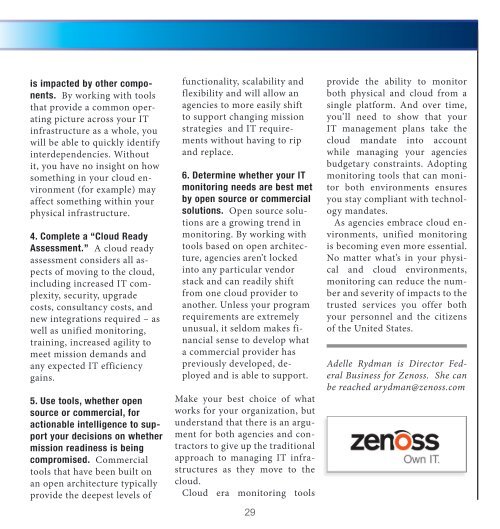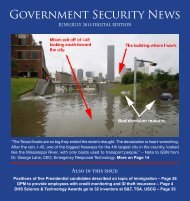GSN Magazine June 2016 Digital Edition
Create successful ePaper yourself
Turn your PDF publications into a flip-book with our unique Google optimized e-Paper software.
is impacted by other components.<br />
By working with tools<br />
that provide a common operating<br />
picture across your IT<br />
infrastructure as a whole, you<br />
will be able to quickly identify<br />
interdependencies. Without<br />
it, you have no insight on how<br />
something in your cloud environment<br />
(for example) may<br />
affect something within your<br />
physical infrastructure.<br />
4. Complete a “Cloud Ready<br />
Assessment.” A cloud ready<br />
assessment considers all aspects<br />
of moving to the cloud,<br />
including increased IT complexity,<br />
security, upgrade<br />
costs, consultancy costs, and<br />
new integrations required – as<br />
well as unified monitoring,<br />
training, increased agility to<br />
meet mission demands and<br />
any expected IT efficiency<br />
gains.<br />
5. Use tools, whether open<br />
source or commercial, for<br />
actionable intelligence to support<br />
your decisions on whether<br />
mission readiness is being<br />
compromised. Commercial<br />
tools that have been built on<br />
an open architecture typically<br />
provide the deepest levels of<br />
functionality, scalability and<br />
flexibility and will allow an<br />
agencies to more easily shift<br />
to support changing mission<br />
strategies and IT requirements<br />
without having to rip<br />
and replace.<br />
6. Determine whether your IT<br />
monitoring needs are best met<br />
by open source or commercial<br />
solutions. Open source solutions<br />
are a growing trend in<br />
monitoring. By working with<br />
tools based on open architecture,<br />
agencies aren’t locked<br />
into any particular vendor<br />
stack and can readily shift<br />
from one cloud provider to<br />
another. Unless your program<br />
requirements are extremely<br />
unusual, it seldom makes financial<br />
sense to develop what<br />
a commercial provider has<br />
previously developed, deployed<br />
and is able to support.<br />
Make your best choice of what<br />
works for your organization, but<br />
understand that there is an argument<br />
for both agencies and contractors<br />
to give up the traditional<br />
approach to managing IT infrastructures<br />
as they move to the<br />
cloud.<br />
Cloud era monitoring tools<br />
29<br />
provide the ability to monitor<br />
both physical and cloud from a<br />
single platform. And over time,<br />
you’ll need to show that your<br />
IT management plans take the<br />
cloud mandate into account<br />
while managing your agencies<br />
budgetary constraints. Adopting<br />
monitoring tools that can monitor<br />
both environments ensures<br />
you stay compliant with technology<br />
mandates.<br />
As agencies embrace cloud environments,<br />
unified monitoring<br />
is becoming even more essential.<br />
No matter what’s in your physical<br />
and cloud environments,<br />
monitoring can reduce the number<br />
and severity of impacts to the<br />
trusted services you offer both<br />
your personnel and the citizens<br />
of the United States.<br />
Adelle Rydman is Director Federal<br />
Business for Zenoss. She can<br />
be reached arydman@zenoss.com







